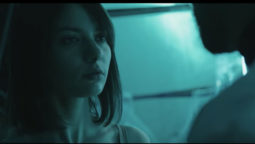When it comes to genre-bending, few artists are as creative as SCI+TEC (and now Turbo Recordings) favorite, Shaded. By day, the California-raised producer looks every bit the West Coast surfer. Place him behind the decks in a dimly-lit room, though, and you have a character as dark and off-kilter as his brand of music. With a flair for funk, muscular bass lines and eerie, distorted VOX elements, Shaded has redefined the term “underground experimental.” He sat down to chat with DJOYBeat about his start with SCI+TEC and his latest release on Tiga‘s Turbo imprint.
For those of us who are not familiar with the Shaded moniker, can you give us a quick run down as to how you made the transition from garage band bass player to techno and tech house producer extraordinaire? What was your path to the underground?
The thing with a band is that you usually have a group of individuals who are all creative on their own level, with their own visions and dreams. So if you can harness all that energy and create something special, that is amazing. When I bailed on the whole band project stuff I was young, like 16 or something… I was very impatient and headstrong on what I thought I wanted. But I look back now and it was the best thing I did, because in leaving that style of music and heading into more electronic based producing I had to teach myself everything. I became really self-reliant musically, so if I had an idea, I could just lay it out right then and there in a sequencer without having to call everyone and organize a band practice. So I guess that feeling of creative freedom and self-expression coupled with my previous love of more left-field music lead me into this underground electronic world.
Take us back to when you first joined the SCI+TEC family. How did that come about?
Before I went solo as Shaded I was a part of a duo named SHDWPLAY. It turned out that my partner had a connection with Dubfire, so I started writing tracks that I felt were suited toward his label SCI+TEC. When we finally were confident in the music we were creating we sent him an email with a couple tracks. After a long time with no word back, we get an email. It was super out the blue, but it was something along the lines of, “Hey guys, digging the music, send me some more! I am playing Cocoon Amnesia in a few days and need some new tracks!” I was so ecstatic that I sat in the studio a week straight and wrote a few more tracks, then sent them over. All of those songs ended up being our first SHDWPLAY release on the label, and the rest is history.
[soundcloud url=”https://api.soundcloud.com/tracks/151387935″ params=”auto_play=false&hide_related=false&show_comments=true&show_user=true&show_reposts=false&visual=true” width=”100%” height=”300″ iframe=”true” /]
Your style is hard to pin down; you use a lot of hip-hop influence and your own distorted vocals, but you also bring this very eerie, futuristic experimental sound. Which directions would you say you lean toward in your music?
My sound is a combination of all the things I love in music. To me, it’s my take on combining funk, hip-hop, techno, house and rock. I never try to categorize music into genres, like “oh man, I only listen to this and that, and I refuse to listen to that genre because I don’t like the scene.” For me it’s very cut and dry: it’s either good music or it’s bad music. I like it or I don’t. So I guess what I have tried to do is take all the music I liked and incorporate it into what I do.
You have now been part of SCI+TEC for quite a while. Are there any new additions to the label family that you have grown close to? Any new projects you are working on for that family?
At the end of the year around December I have my fourth EP as Shaded coming out on SCI+TEC. Unlike any other release I have done, it will have some remixes on it. I have never had anyone remix my music before so it’s pretty exciting for me. Toward the end of the year we will announce the remixers, but for now it’s a little secret.
Tell us about the new EP you have out on Tiga’s label, Turbo Recordings. What was the inspiration for “Sheshe?”
My Turbo EP was really special for me because musically it is very relative to where I am right now as an artist. It’s a bit more funky than my SCI+TEC stuff, but still very techno and minimal in character. I tailor a lot of the music to fill areas of my live set. I remember wanting to add more funk style stuff to the set, hence the creation of the whole Sheshe EP.
What is the story behind the name?
There is no real story behind the name. Sometimes I will just be walking down the street and think of some weird cool word and write it down on my phone or something. Or sometimes I will be exporting out the final audio file and the name just clicks so I name it that right on the spot. I do use a lot of VOX elements in my songs, and find that I tend to name songs after whatever vocals I use.
The EP is very minimal and basic, but it has that great booming big room sound. How was this possibly a departure from some of your other work, and in what ways did you go about keeping it dance floor oriented and unique?
I wouldn’t say it’s a departure, rather an expansion. I am constantly trying to expand the sound, the swing and the groove. Playing live can be a tricky thing, because you have to get more creative with your own music. It’s not like DJing, where your pallet of music can be infinite. When playing live you only have the tools you created to work with. So for me, expanding the sound allows me to take my live sets in different directions. In terms of keeping a track floor-oriented, I have come to this conclusion: if your track can swing with just a bass drum, bass line and snare, then it will work great on the floor.
[soundcloud url=”https://api.soundcloud.com/tracks/151388075″ params=”auto_play=false&hide_related=false&show_comments=true&show_user=true&show_reposts=false&visual=true” width=”100%” height=”300″ iframe=”true” /]
When it comes to techno, sometimes the more stripped-back and minimal stuff runs the risk of sounding like everything else. However, even when you go very minimal you still manage to create a sound that stands out and has your signature all over it. At the risk of getting abstract, what’s your “signature” and how do you bring depth to a tune with very simplified elements?
I always loved hearing or seeing music or art and being able to tell who the artist was without knowing. I think that is a very cool thing, and sometimes difficult to achieve these days with so many talented people out there. Paying attention to detail and knowing exactly what you personally want to hear or feel is key. The only way to create a signature sound is to forget about pleasing everyone else, and to ensure first and foremost that you are the one who is happy with the sound. Once you know exactly what you want, you are able to expand and elaborate on that to add your signature. There are still times when I write a bass line and think, “Wow, this is the best one I have ever done!” I couldn’t tell you how I do it, because I really don’t know. I just do what I think is cool and go from there… maybe it’s just a subconscious thing.
Last but not least, anything in the works right now that we should keep an ear out for?
Well I just had a long studio bender and have created a lot of new material. Over the next few weeks I am going to be testing it on the road at gigs to see how it goes, and if the tracks are well received then I will be looking to release them. Also, I just finished my own edit of the Notorious B.I.G track “Going Back To Cali,” so keep your ears open for that and a sneak peak online. Other than that, I will be gigging a lot as well while also trying to finish up this full audiovisual live show I have been trying to finish for quite a while now. Lots of new stuff on the horizon!
[soundcloud url=”https://api.soundcloud.com/tracks/159123601″ params=”auto_play=false&hide_related=false&show_comments=true&show_user=true&show_reposts=false&visual=true” width=”100%” height=”300″ iframe=”true” /]







Join the discussion
comments powered by Disqus